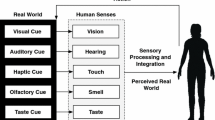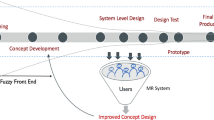Abstract
Designing new products according to user needs and requirements is a key success factor for companies. However, the characterization of user requirements in the early design stages is not an easy task due to the subjective nature of these requirements and because of the communication gap between users and designers. Digital design tools have the potential to enable users to actively participate in the design process and to directly interact with representations of the future product. Yet, they suffer a trade-off between their ability to accurately represent the user experience with the future product and their capacity to offer simple interfaces for the end user to manipulate. To overcome this issue, we introduce a new modular digital tool that allows users to become active participants of the design process through a high level of both immersion and control. The tool consists in a combination of a virtual reality environment for immersion and intuitive physical interfaces for direct control, resulting in a mixed reality hardware/software system. The hardware is made of modular tangible user interfaces (TUIs), custom-made by 3D printing and powered by a 3D game engine while the interactive content is displayed in virtual reality. The modularity of the system allows several TUIs and 3D content behaviours configurations to bring user friendliness and intuitively for each specific design project.














Similar content being viewed by others
Change history
24 May 2017
An erratum has been published.
References
Arrighi, P.-A., Le Masson, P., & Weil, B. (2015). Managing radical innovation as an innovative design process: Generative constraints and cumulative sets of rules. Creativity and Innovation Management, 24(3), 373–390. doi:10.1111/caim.12135.
Bayus, B., & Putsis, W. P. Jr. (1999). Product proliferation: An empirical analysis of product line determinants and market outcomes. Marketing Science.
Bordegoni, M., & Ferrise, F. (2013). Designing interaction with consumer products in a multisensory virtual reality environment: This paper shows how virtual reality technology can be used instead of. Virtual and Physical Prototyping, 8(1), 51–64.
Bordegoni, M., Ferrise, F., & Lizaranzu, J. (2011). Use of interactive virtual prototypes to define product design specifications: A pilot study on consumer products. In 2011 IEEE international symposium on VR innovation (pp. 11–18). doi:10.1109/ISVRI.2011.5759592.
Cai, M. Y., Lin, Y., Han, B., Liu, C. J., & Zhang, W. J. (2016). On a simple and efficient approach to probability distribution function aggregation. IEEE Transactions on System, Man and Cybernetics, Part A. doi:10.1109/TSMC.2016.2531647.
Carlile, P. R. (2002). A pragmatic view of knowledge and boundaries: Boundary objects in new product development. Organization Science, 13(4), 442–455. doi:10.1287/orsc.13.4.442.2953.
Carulli, M., Bordegoni, M., & Cugini, U. (2013). An approach for capturing the voice of the customer based on virtual prototyping. Journal of Intelligent Manufacturing, 24(5), 887–903.
Cecil, J., & Kanchanapiboon, A. (2006). Virtual engineering approaches in product and process design. The International Journal of Advanced Manufacturing Technology, 31(9–10), 846–856. doi:10.1007/s00170-005-0267-7.
Cox, W., & Alm, R. (1998). The right stuff: America’s move to mass customization. Economic Review-Federal Reserve Bank of Dallas, 3, 48.
Da Silveira, G., Borenstein, D., & Fogliatto, F. (2001). Mass customization: Literature review and research directions. International Journal of Production Economics, 71(1), 1–13.
Davis, S. (1987). Future perfect. Reading, MA: Addison-Wesley Publishing.
Du, X., Jiao, J., & Tseng, M. (2006). Understanding customer satisfaction in product customization. The International Journal of Advanced Manufacturing Technology, 31(3–4), 396–406.
Enomoto, N., Nomura, J., Sawada, K., Imamura, K., & Nagamachi, M. (1995). Kitchen planning system using kansei VR. Advances in Human Factors/Ergonomics, 20, 185–190.
Ferrise, F., Graziosi, S., & Bordegoni, M. (2015). Prototyping strategies for multisensory product experience engineering. Journal of Intelligent Manufacturing. doi:10.1007/s10845-015-1163-0.
Fornell, C., Johnson, M., & Anderson, E. (1996). The American customer satisfaction index: Nature, purpose, and findings. The Journal of Marketing, 60, 7–18.
Fukuda, S., & Matsuura, Y. (1993). Prioritizing the customer’s requirements by AHP for concurrentdesign. In ASME design engineering division publications DE (Vol. 52, pp. 13–19). New York: ASME.
Füller, J., & Matzler, K. (2007). Virtual product experience and customer participation—A chance for customer-centred, really new products. Technovation, 27(6–7), 378–387. doi:10.1016/j.technovation.2006.09.005.
Hamade, R. F., & Artail, H. A. (2008). A study of the influence of technical attributes of beginner CAD users on their performance. Computer-Aided Design, 40(2), 262–272. doi:10.1016/j.cad.2007.11.001.
Hart, C. W. L. (1995). Mass customization: Conceptual underpinnings, opportunities and limits. International Journal of Service Industry Management, 6(2), 36–45. doi:10.1108/09564239510084932.
Helms, M. M., Ahmadi, M., Jih, W. J. K., & Ettkin, L. P. (2008). Technologies in support of mass customization strategy: Exploring the linkages between e-commerce and knowledge management. Computers in Industry, 59(4), 351–363. doi:10.1016/j.compind.2007.09.003.
Helo, P. (2006). Product configuration analysis with design structure matrix. Industrial Management & Data Systems, 106(7), 997–1011.
Hideyoshi, Y., & Fukuda, S. (2004). Development of interactive industrial design support system considering customer’s evaluation. JSME International Journal Series C, 47(2), 762–769. doi:10.1299/jsmec.47.762.
Hsu, J.-M. (2010). Design and evaluation of virtual home objects with music interaction in smart homes. Journal of Intelligent Manufacturing, 23(4), 1281–1291. doi:10.1007/s10845-010-0411-6.
Hunt, D. (2006). A consumer perspective on mass customization. Ph.D Dissertation, Faculty of the Graduate School, University of Missouri-Columbia.
Huyett, W., & Viguerie, S. (2005). Extreme competition. McKinsey Quarterly, 1, 46–57.
Hvam, L. (2006). Mass customisation in the electronics industry: Based on modular products and product configuration. International Journal of Mass Customisation, 1(4), 410–426.
Imamura, K., Nomura, J., & Nagamachi, M. (1994). Virtual space decision support system using kansei engineering. In Japan–USA symposium on flexible automation, II (pp. 549–555).
Ishii, H., & Ullmer, B. (1997). Tangible bits: Towards seamless interfaces between people, bits and atoms. In Proceedings of the SIGCHI conference on human factors in computing systems CHI 97 (Vol. 39, pp. 234–241). doi:10.1145/258549.258715
Jiao, J., Ma, Q., & Tseng, M. (2003). Towards high value-added products and services: Mass customization and beyond. Technovation, 23(10), 809–821.
Kahn, B. (1998). Variety: From consumer’s perspective. In T. H. Ho & C. S. Tang (Eds.), Product variety management: Research advances (pp. 19–37). Berlin: Springer.
Khurana, A., & Rosenthal, S. (1997). Integrating the fuzzy front end of new product development. MIT Sloan Management Review, 38(2), 103–120.
Leithinger, D., Lakatos, D., DeVincenzi, A., Blackshaw, M., & Ishii, H. (2011). Direct and gestural interaction with relief. In Proceedings of the 24th annual ACM symposium on user interface software and technology—UIST ’11 (p. 541). New York, NY: ACM Press. doi:10.1145/2047196.2047268
Lihra, T., Buehlmann, U., & Beauregard, R. (2008). Mass customisation of wood furniture as a competitive strategy. International Journal of Mass Customisation, 2(3), 200–215.
Lihra, T., Buehlmann, U., & Graf, R. (2012). Customer preferences for customized household furniture. Journal of Forest Economics, 18(2), 94–112. doi:10.1016/j.jfe.2011.11.001.
Lin, Y., & Zhang, W. J. (2006). Integrated design of function, usability, and aesthetics for automobile interiors: State-of-the-art, challenges, and solutions. Proceedings of the IMechE Part I, Journal of Systems and Control Engineering, 220(18), 697–708.
Magretta, J. (1998). The power of virtual integration: An interview with Dell Computers’ Michael Dell. Harvard Business Review, pp. 74–84.
Medyna, G., Nonsiri, S., Coatanéa, E., & Bernardb, A. (2012). Modelling, evaluation and simulation during the early design stages: Toward the development of an approach limiting the need for specific knowledge. Journal of Integrated Design and Process Science, 16(3), 111–131. doi:10.3233/jid-2012-0006.
Milgram, P., & Kishino, F. (1994). A taxonomy of mixed reality visual displays. IEICE Transactions on Information and Systems. The Institute of Electronics, Information and Communication Engineers, 72(12), 1321–1329.
Nagamachi, M. (2008). Perspectives and the new trend of Kansei/affective engineering. The TQM Journal, 20(4), 290–298. doi:10.1108/17542730810881285.
Nagamachi, M. (2010). Kansei/affective engineering. New York: CRC Press.
Ninan, J. A., & Siddique, Z. (2006). Internet-based framework to support integration of customer in the design of customizable products. Concurrent Engineering, 14(3), 245–256. doi:10.1177/1063293X06068391.
Ogi, T., Tateyama, Y., & Haruyama, S. (2010). Education on human centered design using virtual environment. In Volume 3: 30th Computers and information in engineering conference, parts A and B (pp. 667–672). ASME. doi:10.1115/DETC2010-28624.
Pahl, G., & Beitz, W. (1988). Engineering design: A systematic approach. NASA STI/Recon Technical Report A, 89, 47350
Perdue, B., & Summers, J. (1991). Purchasing agents’ use of negotiation strategies. Journal of Marketing Research, 28(2), 175–189.
Petiot, J.-F., & Yannou, B. (2004). Measuring consumer perceptions for a better comprehension, specification and assessment of product semantics. International Journal of Industrial Ergonomics, 33(6), 507–525. doi:10.1016/j.ergon.2003.12.004.
Piller, F. (2007). Observations on the present and future of mass customization. International Journal of Flexible Manufacturing Systems, 19(4), 630–636.
Pine, B. (1993). Mass customization: The new frontier in business competition. Academy of Management Review, 19(3), 588–592.
Rautenstrauch, C., Seelmann-Eggebert, R., & Turowski, K. (2012). Moving into mass customization: Information systems and management principles. Berlin/New York: Springer.
Richards, D., Boettger, K., Fure, A. B., & Oscar, A. (2003). Requirements reconciliation using a computer supported collaborative approach. Journal of Integrated Design and Process Science, 7(2), 113–129.
Sanders, E. B.-N., & Stappers, P. J. (2008). Co-creation and the new landscapes of design. CoDesign, 4(1), 5–18. doi:10.1080/15710880701875068.
Schütte, S. T. W., Eklund, J., Axelsson, J. R. C., & Nagamachi, M. (2004). Concepts, methods and tools in Kansei engineering. Theoretical Issues in Ergonomics Science, 5(3), 214–231. doi:10.1080/1463922021000049980.
Shah, S. G. S., & Robinson, I. (2007). Benefits of and barriers to involving users in medical device technology development and evaluation. International Journal of Technology Assessment in Health Care, 23(1), 131–137. doi:10.1017/S0266462307051677.
Sidharta, R., Oliver, J., & Sannier, A. (2006). Augmented tangible interfaces for product assembly planning. International Journal of Product Lifecycle Management, 1(3), 321–333.
Slater, M., Linakis, V., Usoh, M., Kooper, R., & Street, G. (1996). Immersion, presence, and performance in virtual environments: An experiment with tri-dimensional chess. In ACM virtual reality software and technology (VRST) (pp. 163–172). Hong Kong: ACM Press.
Thornton, L. G. (2006). Survey of US business leaders (12th ed., 16 pp). Chicago, IL: Grant Thornton International.
Toffler, A. (1970). Future shock. New York: Amereon Ltd.
Trentin, A., Perin, E., & Forza, C. (2012). Product configurator impact on product quality. International Journal of Production Economics, 135(2), 850–859. doi:10.1016/j.ijpe.2011.10.023.
Trentin, A., Perin, E., & Forza, C. (2014). Increasing the consumer-perceived benefits of a mass-customization experience through sales-configurator capabilities. Computers in Industry, 65(4), 693–705. doi:10.1016/j.compind.2014.02.004.
Tseng, M. M., & Piller, F. T. (2003). The customer centric enterprise: Advances in mass customization and personalization (536 pp). Berlin, Heidelberg: Springer.
Van der Vegte, W. F., & Horváth, I. (2002). Consideration and modeling of use processes in computer-aided conceptual design: A state of the art review. Journal of Integrated Design and Process Science, 6(2), 25–59.
Wan, Z., & Bullard, S. (2008). Firm size and competitive advantage in the US upholstered, wood household furniture industry. Forest Products Journal, 58(1/2), 91–96.
Wang, L., Shen, W., Xie, H., Neelamkavil, J., & Pardasani, A. (2002). Collaborative conceptual design-state of the art and future trends. Computer-Aided Design, 34(13), 981–996. doi:10.1016/S0010-4485(01)00157-9.
Zeithaml, V. A. (1988). Consumer perceptions of price, quality, and value: A means-end model and synthesis of evidence on JSTOR. Journal of Marketing. doi:10.2307/1251446.
Author information
Authors and Affiliations
Corresponding author
Rights and permissions
About this article
Cite this article
Arrighi, PA., Mougenot, C. Towards user empowerment in product design: a mixed reality tool for interactive virtual prototyping. J Intell Manuf 30, 743–754 (2019). https://doi.org/10.1007/s10845-016-1276-0
Received:
Accepted:
Published:
Issue Date:
DOI: https://doi.org/10.1007/s10845-016-1276-0




